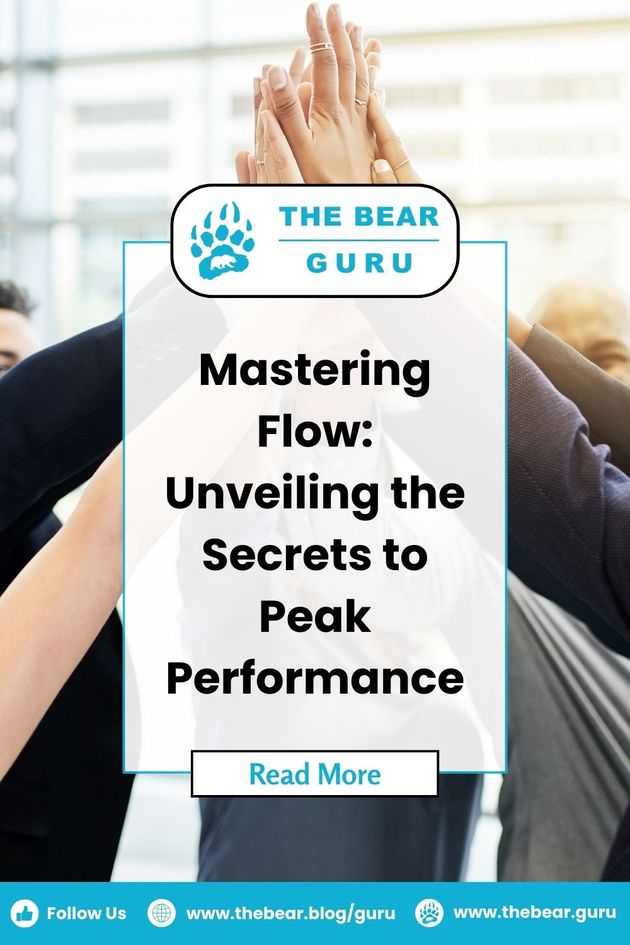Mastering Flow: Unveiling the Secrets to Peak Performance
If you've been so caught up in an undertaking that you forget about time, you've encountered flow. In any case, being in a flow state accomplishes something other than making the day appear to speed up. It affects your life, well-being, efficiency, and prosperity positively.
To fully appreciate the transformative nature of the flow state, you'll have to comprehend what it is and how it works. Explore the science behind flow and uncover ways to harness its potential, elevate your productivity, enrich your life, and achieve peak performance.
🏆 Guru Trivia!
Productivity and creativity skyrocket when you're in a flow state.
Comprehend Yourself Better
Figure out how to use your normal ability to decide your next line of action and achieve your objectives more efficiently.
Mihály Csíkszentmihályi, a renowned psychologist often hailed as one of the pioneers of positive psychology, was the first to identify and delve into the phenomenon of flow. Regardless of whether you've never heard the word, you probably have your own ways of describing the sensation or different names for the experience. Some may refer to it as being "in the zone," "losing track of time," or "in the groove.
Understanding the Flow State
The flow state refers to the immersive sensation of being completely absorbed in a task that is both enjoyable and engaging. During this state, distractions fade, and you lose track of self-consciousness and time.
In the flow state, there's a sense of effortless focus, where you can sustain the activity indefinitely. While the triggers for entering flow vary, they can manifest during activities such as reading, writing, painting, running, or gardening.
Although there's no guaranteed formula for inducing flow, there are common characteristics associated with the experience. While not all may be present simultaneously, multiple factors increase the likelihood of experiencing flow.
The Inner Workings of the Flow State
What sets the flow state apart? Neuroscience has yet to be completely explained, but researchers recognize it as a unique state of mind. It emerges when the challenge level of a task aligns harmoniously with the individual's skill level.
Engaging in a task that is both stimulating and within one's capabilities allows the brain to enter a state of relaxed focus. The brain's central executive network (CEN) takes charge during such moments.
Conversely, the default mode network (DMN) dominates during idle moments. Despite its association with daydreaming, the DMN plays a significant neurological role. Interestingly, this part of the brain remains highly active during flow.
In a flow state, the mind becomes fully absorbed in the task at hand, seemingly freeing up other parts of the brain to make connections and synthesize information. Despite being engaged in work, flow is inherently pleasurable and beneficial. Dopamine release occurs during flow, leading to feelings of heightened optimism, relaxation, empowerment, and commitment to the task at hand.
How to Achieve the Flow State?
Understanding how flow operates enables you to tailor your schedule and environment to be conducive to flow. Here are steps to help you consistently enter and sustain the flow state.
#1 Establishing Clear Objectives
Entering a flow state often involves tackling a task with a defined and tangible outcome. Clarity regarding the purpose and expected results of the task facilitates focus and concentration. While setting a deadline or specific endpoint can provide a sense of direction, it's equally important for the task to have a clear and meaningful objective.
When you precisely understand the task and its intended outcome, engaging fully and immersing yourself in the process becomes easier. Rather than simply working towards a deadline, having a clear objective allows you to work with purpose and intentionality. This clarity enhances productivity and instills a sense of control and satisfaction as you progress toward achieving your goals.
#2 Make it Difficult
#3 Make it Simple to Concentrate
To improve concentration, schedule uninterrupted work periods in your day. Identify when you're most alert and productive and block them off for focused tasks. Understanding your circadian rhythms can optimize your schedule, ensuring peak performance during these periods.
By structuring your day to prioritize concentration, you are able to create an environment conducive to deep focus and productivity, empowering you to achieve your goals efficiently.
#4 Make Yourself Comfortable
While in a state of flow, it's common to become absorbed in tasks to the point of neglecting basic needs like food, water, and movement. While this intense focus can enhance productivity, it's important to prioritize your physical comfort and health. Developing routines that promote comfort and well-being can help you sustain longer flow periods.
Consider keeping water and snacks nearby, ensuring proper ventilation in your workspace, and using a comfortable chair to support your posture. By giving attention to your physical needs, you can prolong your ability to maintain focus and productivity while in the flow state.
#5 Minimize Distractions
To prevent interruptions and maintain focus, it's crucial to disconnect from all forms of communication, particularly your phone. Even when you've set aside time for focused work, the presence of a phone can be a significant source of distraction. Inform others of your unavailability and then switch off your phone or set it to silent mode to avoid disruptions.
Additionally, disabling notifications can further reduce the temptation to check your phone unnecessarily. You create a conducive environment for deep concentration and uninterrupted workflow by eliminating potential distractions.
#6 Establish a Pre-flow Routine
Prepare your mind for focused work by establishing a pre-flow routine. This ritual signals your brain that it's time to transition into deep concentration. Your routine can be tailored to your preferences and the specific task. For example, before starting a writing session, you might review your messages, silence your phone, and take a moment to enjoy a drink.
While your routine doesn't need to be rigid or formal, it should effectively prime your mind for the upcoming task. By consistently following this pre-flow ritual, you train your brain to enter a state where there is heightened focus and productivity, ensuring you can seamlessly transition into your work.
#7 Understand Yourself
Achieving flow is challenging when we're engaged in tasks that fail to resonate with our interests or abilities. However, it's essential to delve deeper into why certain tasks elicit negative feelings. Is it the monotony that makes the task boring, the complexity that renders it too difficult, or the physical or mental strain that makes it exhausting?
Consider the information passage model: it's effortless to enter a flow state when we're passionate about the task at hand. Therefore, it's crucial to identify what activities we genuinely enjoy and excel at. By understanding our preferences and strengths, we can align our tasks with our passions, making it easier to enter a flow state. Ultimately, self-awareness empowers us to cultivate environments and experiences that foster flow, increasing our endeavors' satisfaction and productivity.
In life, we may not be able to enjoy everything we do; however, we can enjoy nearly anything. If we work to find something worth learning in each activity, we can achieve a flow experience in almost anything. Expecting to encounter this flow as frequently as possible leads to more joyful and wonderful lives.
Qualities of the Flow State
The flow state, characterized by intense focus and effortless immersion in an activity, encompasses several key qualities that contribute to its transformative nature. Understanding these defining characteristics sheds light on the unique flow experience and its profound impact on performance and well-being.
-
Rapt Attention: In the flow state, you're completely absorbed in the task, with unwavering concentration. External distractions require considerable effort to break your focus, as your attention is fully engaged.
-
Optimal Challenge: The task in flow must strike the perfect balance of challenge. It should be neither easy nor difficult but challenging enough to captivate your interest and skill.
-
Goal-oriented: Flow requires a clear objective to guide your focus. Whether completing a puzzle or playing a game, having a specific goal helps channel your attention and sustain engagement.
-
Immediate Feedback: Flow activities provide immediate feedback, such as winning a game or completing a level. This instant feedback fuels your motivation and reinforces your sense of competence, keeping you engaged in the task.
-
Individual Control: Flow is hindered when you lack control over the situation or activity. Maintaining a sense of agency and autonomy is essential for achieving and sustaining the flow state.
-
Timelessness: In flow, time seems to lose significance as you become fully immersed in the activity. This altered perception of time can result in either time flying by or slowing down, leaving you surprised when you eventually check the clock.
-
Harmony and Inner Peace: Flow is characterized by tranquility and inner harmony. You feel relaxed and free from stress or anxiety despite being deeply engrossed in the task. This calmness extends beyond the flow experience, contributing to the well-being and emotional balance.
🏆 Guru Fact!
Instigating flow is about the harmony between the degree of ability and the importance of the challenge.
Flow Unleashed: Navigating the Path to Fulfillment
In summary, the flow state embodies a unique synergy of attention, challenge, and intrinsic motivation, fostering an immersive and rewarding experience across diverse activities. By aligning the task's difficulty with individual skill levels and maintaining clear goals, individuals can optimize their chances of entering the flow and unlocking their full potential.
Moreover, the feedback loop, sense of control, and temporal distortion characteristic of flow contribute to a profound sense of harmony and well-being, transcending mere productivity to encompass holistic fulfillment and self-actualization. Ultimately, understanding and harnessing the qualities of flow can empower individuals to cultivate environments and experiences conducive to optimal performance, joy, and personal growth.
Recommended for you
Travel to Phuket: A Hopping Day Trip Itinerary to its Stunning Islands
Sydney, The Bear Traveler (The Bear Travel)
Three Pagodas Pass: A Symbol of Peace in Kanchanaburi
The Bear Team
Top 10 Signs that You Suffer from Identity Crisis While in Thailand
Jamie (Curious Bear)
Thailand Golf: Greenwood Golf & Country Club in Pattaya
The Bear Team
Nectar Café: Refreshing Craft Beer Taps at Sathorn in Bangkok
Tle (Hungry Bear)





















